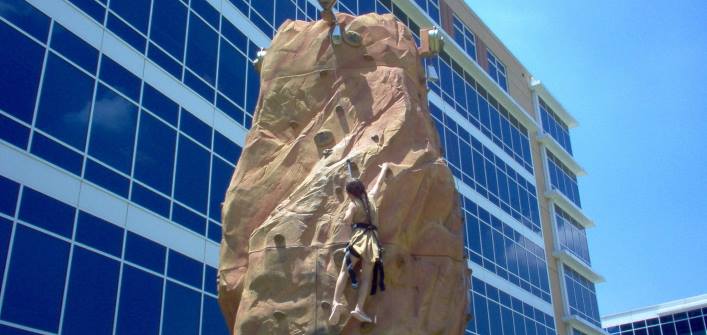
Not that many years ago, rock wall climbing was the province of extreme sport enthusiasts and simply a novelty experience for everyone else.
In recent years, that has changed.
More and more people have discovered the fun of climbing rock walls and are also experiencing the health benefits – something few considered when rock walls first started appearing at fairs and special events.
Where Rock Climbing Started
Rock walls started because of the dedication of regular rock and mountain climbers. Feeling they needed practice, rock climbers used rock walls to practice. But by the 1980s, rock walls had become an activity enjoyed by millions.
Rock climbing itself comes in a variety of forms, which are mirrored on rock walls. They include some of the following.
Bouldering. This involves climbing rocks at low levels, without using ropes or harnesses. There are often safety mats in place below.
Sports climbing. Climbers, usually attached to a harness or rope of some kind, climb vertical rock walls with bolts that climbers can clip onto.
Soloing. Climbing unmarked paths, typically without any kind of rope.
Physical Benefits of Rock Wall Climbing
Rock wall climbing – and climbing rock walls – can do a lot for your health. Here are some of the areas where you are likely to see improvement if you climb regularly,
Arm strength. You can’t help but improve your arm strength as you pull yourself up walls. The same can be said for your shoulders and thigh muscles, both of which will built up over time as you rock climb.
Neck muscles. Neck muscles will also get stronger the more you climb because you use them to look around as well as up and down.
Cardio. Overall, rock climbing tends to be a low impact cardio workout, but your breathing and heart rate will improve the longer you routinely rock climb.
Mental and Emotional Benefits of Rock Climbing
Like other forms of exercise, rock climbing requires you to set goals and then achieve them, which in itself can be a great boost to your mental health. It can also give your increased confidence in your mental and physical abilities.
Here are some of the other areas rock climbing can improve your mental and emotional health.
Problem solving. Much like working a puzzle, rock wall climbing requires you to work out each hand and foot placement. Research has shown such mental activity is good for your overall health.
Battling mental health issues. Rock climbing can even help with mental health issues such as depression. Because you are focused on the moment, free of worries about the past or the future, rock climbing (like other forms of exercise) can help you manage mental health issues.
Stress relief. Rock climbing also provides great stress relief for many of the same reasons listed above – physical exercise and a chance to focus on the moment and not worry about periphery issues.
Perseverance. This ties in with goal setting and confidence-building. Rock wall climbing can be fun but also difficult, and reaching the top can give you a feeling of accomplishment that is impossible to replicate any other way. And it can teach you that no matter the difficulties, working hard and seeing things through can lead to success.
Like other kinds of exercise, rock wall climbing can be an important part of staying happy and healthy. And thanks to the prevalence of rock walls at various events and the growing number of party rental companies that have rock walls, access to one has never been easier.


I never considered how rock climbing could benefit mental health in addition to physical health. I live near a mountain range that has a lot of great places to rock climb. I have noticed that just being in the mountains is a great way for one to clear his or her mind and find relief from anxiety and stress.
My son is deathly afraid of heights but he recently told me that he wanted to overcome his fear of heights by trying out wall climbing. I never knew that wall climbing doesn’t just improve physical wellness, but also has mental benefits as this enhances a person’s problem-solving skills because it requires the proper placement of your hands and feet on specific spots in order to advance onward.